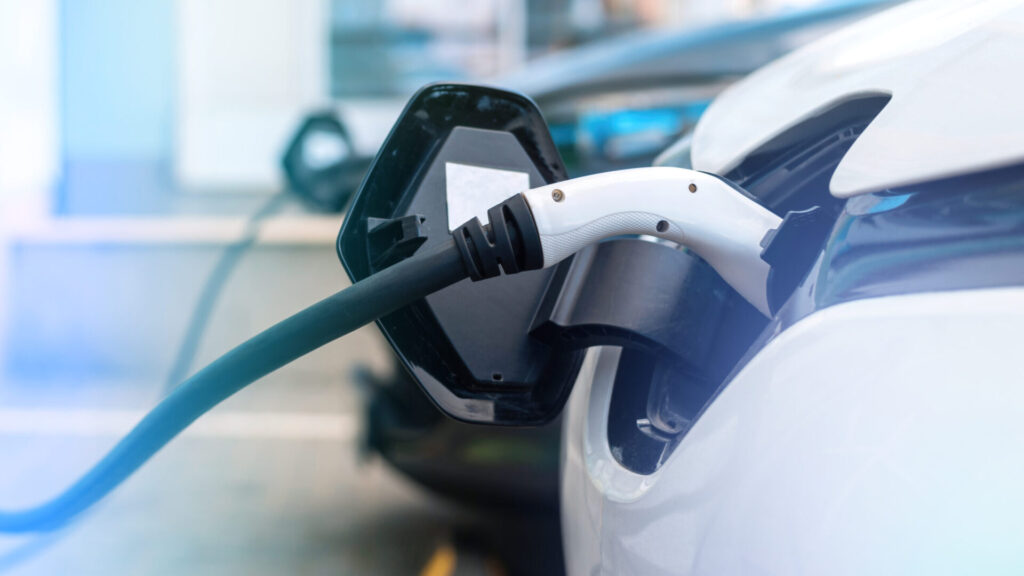Avoid the pitfalls when buying an EV.

Plugged in chargers into two electric cars at charge station
Electric cars are no longer the preserve of the early adopters and tech enthusiasts. Their growing popularity, aided by a broader model range and falling prices, means that more people than ever are considering used electric vehicles (EVs) as their next car. While the transition from petrol or diesel to battery power is not rocket science, there are some nuances that would-be buyers need to understand before they take the plunge.
First and foremost, assess your circumstances. You must be able to charge the car reliably and regularly. If you’ve off-street parking at home, installing a domestic charge point should be straightforward, and it remains the cheapest and most convenient way to charge your EV. For others, proximity to on-street chargers or workplace facilities may suffice. Without one of these options, running an electric vehicle may quickly turn from novelty to nuisance.
Installation costs for home chargers are not small, typically ranging from £800 to £1,000, so this should be factored into your budget. Some energy suppliers now offer EV tariffs that include a charger as part of the deal. Meanwhile, buyers going through main dealers or using company salary sacrifice schemes may find wallboxes bundled into the package, though this is still far from common.
Then there’s the question of range. This is where many people come unstuck, because they focus on unlikely scenarios, like a 500-mile midnight dash, instead of their actual daily driving needs. Most commonly used electric vehicles (EVs) easily cover 100 miles on a single charge, with newer models going well past 300 miles. A simple way to determine what suits you is to track your mileage over a week or two using an app. It’s usually an eye-opener and may reveal you don’t need the most expensive model to suit your lifestyle.
Once you’ve found a car that ticks the right boxes, it’s time to dig deeper, particularly when it comes to the battery. Knowing the battery’s state of health can provide crucial insight into how well the car has aged and what kind of range you can expect in real-world conditions. Most modern EVs will show the state of charge and, in some cases, the state of health directly on the dashboard. But that only scratches the surface.
A proper test drive can reveal a lot; fully charge the car and see how the real range compares to the official figures. For a more comprehensive view, some service centres now offer full diagnostic scans. These can assess internal resistance and remaining capacity, providing a clearer indication of what’s happening inside the battery. A growing number of dealers even include battery health certification as part of the sale, with companies like Aviloo and DEKRA offering formal reports that many buyers are starting to expect as standard.
Some apps and tools extend beyond what the car displays to you. Some third-party platforms, such as ClearWatt, utilise telematics to track usage and calculate battery condition over time. Manufacturer apps can also provide historical charging behaviour and health statistics, though they may require a compatible OBD reader and some technical knowledge.
The good news for buyers is that the used EV market has become much more affordable. The values of used electric cars have fallen sharply since 2022. According to industry data, prices for some high-end models, such as the Jaguar I-Pace and Porsche Taycan, have dropped by over £20,000, and in some cases, by as much as £40,000, making them more accessible to buyers who wouldn’t have previously considered them. A second-hand Nissan Leaf now regularly sells for under £10,000, while Teslas under £20,000 are no longer rare sightings.
Despite this, it’s critical not to jump at the first deal you find. Classified listings can provide a solid benchmark for prices, but take the time to compare similar models. Use tools like the HPI Check to investigate the vehicle’s background and get an accurate sense of what you’ll be spending over the next few years. A Total Cost of Ownership calculator is particularly useful for identifying hidden expenses and planning your finances accordingly.
Battery warranties also deserve close inspection. Most manufacturers offer a separate cover for the battery, typically for around eight years or 100,000 miles. However, like any warranty, it’s only valid if the car has been properly maintained, so be sure to check the service records.
And, of course, test drive the car, ideally for as long as the seller will allow. Driving an EV is a different experience: the quietness, instant torque, and lack of gears catch many people off guard. But for most, it’s a pleasant surprise. Some dealers even offer 24-hour test drives – worth taking advantage of if you’re on the fence.
When it comes to finance, CarMoney advises against simply accepting the first rate you’re offered. Ask the dealer whether they work with brokers who have access to a wider pool of lenders. You’ll be surprised how much the rate can vary. Use a car finance calculator to work out how much you can afford. There’s plenty of choice in the broker market, and switching could save you hundreds over the life of the agreement.
Alastair Grier, CEO of CarMoney, advises: “Buying a car doesn’t have to be stressful. If you approach it with a plan, conduct thorough research, and understand your options, it becomes a far more confident and positive experience. The key is to not rush and to know where you can lean on expertise, especially when it comes to finding the right finance.”
It also pays to check the cost of insuring the car. EVs can sometimes sit in higher insurance groups than their petrol or diesel equivalents because of their typically higher repair costs, specialist parts and the price of battery replacements in the event of damage. As a result, premiums can be steeper than you might expect, particularly for younger drivers or performance-oriented electric models.
While specialist electric vehicle insurers have entered the market with tailored policies, it’s still worth shopping around to find the best deal and avoiding a shock after the sale.
Don’t forget extras like charging cables, which are not always included in the sale. Ask to see them and check their condition because a replacement set can cost upwards of £100.
Ultimately, buying a used EV doesn’t need to be a minefield. With a bit of legwork, realistic expectations and a firm grasp of your personal needs, it can be a straightforward and rewarding switch. Just be sure to go in with your eyes open and with a charger at the ready.
For more information visit: https://www.carmoney.co.uk/





